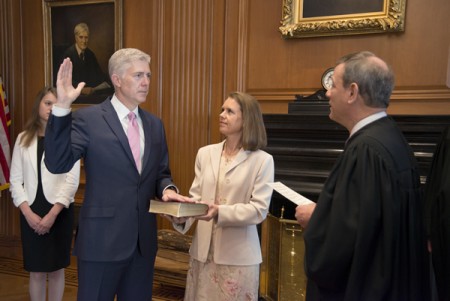Is Gorsuch the new Scalia? He lectures colleagues and aligns himself with Thomas

Neil M. Gorsuch being sworn in as a Supreme Court Justice in April.
Justice Neil M. Gorsuch has quickly staked out conservative positions and aligned himself with Justice Clarence Thomas since joining the U.S. Supreme Court.
Gorsuch appears to be even more of an originalist than the justice he replaced, the late Antonin Scalia, according to a Wall Street Journal op-ed (sub. req.) by law professors John Yoo of the University of California at Berkeley and Sai Prakash of the University of Virginia.
Scalia once called himself a “fainthearted originalist” and he sometimes adhered to established precedent rather than the constitutional text, according to the professors. Thomas takes more consistent originalist positions.
Scalia wrote the opinion finding an individual right to bear arms under the Second Amendment, but he acknowledged a right to regulate gun possession, Yoo and Prakash say. When the U.S. Supreme Court declined to hear a California case on the right to carry guns in public, Gorsuch joined Thomas in a dissent expressing strong Second Amendment support.
How often did Gorsuch agree with Thomas? SCOTUSblog statistics (PDF) show 100 percent agreement in voting for the same disposition, NPR reports. But he wasn’t a mere follower, according to the New York Times.
Gorsuch’s “early opinions were remarkably self-assured,” the Times reported. “He tangled with his new colleagues, lectured them on the role of the institution he had just joined, and made broad jurisprudential pronouncements in minor cases.”
In June, Gorsuch wrote one majority opinion, three dissents and three concurrences, according to the Times. In one dissent and one majority opinion, Gorsuch stressed his views on adhering to the statutory text in interpreting laws.
“While it is of course our job to apply faithfully the law Congress has written,” he wrote, “it is never our job to rewrite a constitutionally valid statutory text under the banner of speculation about what Congress might have done had it faced a question that, on everyone’s account, it never faced.”
Gorsuch dissented, in an opinion joined by Thomas and Justice Samuel Anthony Alito Jr., when the high court ruled that the U.S. Constitution requires the state of Arkansas to list gay spouses on birth certificates.
Gorsuch wrote a concurrence, joined by Thomas, that mostly agreed with a Supreme Court decision finding that a church’s free-exercise rights were violated when it was denied a state grant to resurface its playground. The disagreement was over a footnote in the majority opinion.
In the travel ban case, Thomas wrote the opinion and Gorsuch joined along with Alito. The group argued that the Supreme Court should have allowed the full travel ban to take effect.
Related articles:
Washington Examiner: “Neil Gorsuch’s first few months begin to reveal how nine-justice Supreme Court will develop”
Los Angeles Times: “Op-Ed Gorsuch is the new Scalia, just as Trump promised”
Bloomberg News: “Gorsuch Joins Thomas as Supreme Court’s New Conservative Anchor”



